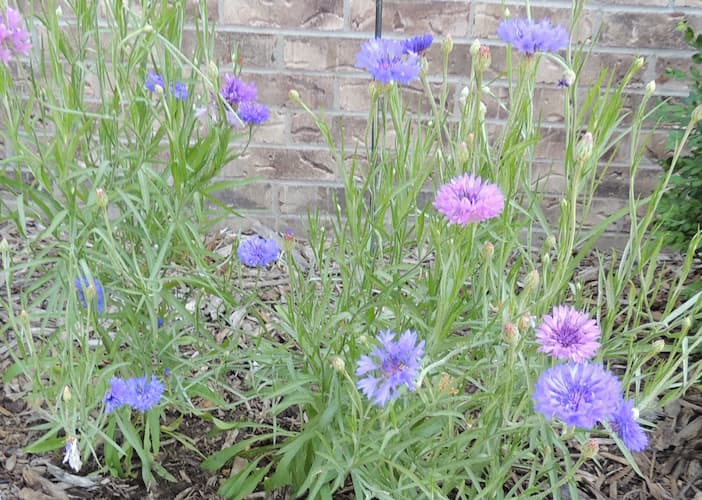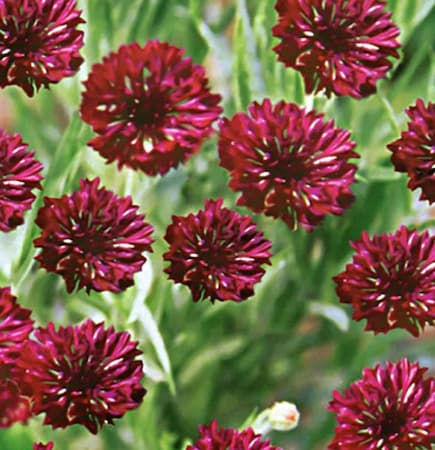How to Grow Bachelor Button Flowers

Growing Bachlor Buttons in Your Home Flower Garden
The versatile Bachelor Button flower has many uses. First, growing these flowers in your garden results in an attractive display. They make great cut or dried flowers for indoor vases and floral displays. And, gentlemen wear them on the lapel of their suit. This guide on “How to Grow Bachelor Button Flowers” will help you to have a profusion of blooms so you can display them in a wide range of creative ways.
Bachelor Buttons are also called Cornflower. Did you know, they are known by yet another name? They are also called the “Boutonniere” flower. That’s because the small, one-inch flowers are perfect for buttonholes on suits. Years ago, they were the rage for boutonnieres. Nowadays, they are less popular for the lapels of suits. Suits are worn far less frequently,
The flowers are most commonly a bright blue. Other flower colors include: white, pink, lavender, red, maroon, and rose. The flowers grow on sparse, thin stems. In addition to boutonnieres, they are also good in fresh flower arrangements or dried. They are frequent members of floral bouquets.
Bachelor buttons put on a nice display, when grown in masses, and look great in cottage gardens. They are an excellent wildflower. And, they grow well in flowerpots on your patio or deck.
Bachelor button flowers attract pollinators and butterflies. Plant these flowers near or in your vegetable garden. It will increase the success of pollination of your vegetables, and result in a higher yield.
Bachelor Button Plant Specifications
Flower Colors: Bule, lavender, maroon, pink, purple, rose, and white. Blue is by far the most common color.
Flowers Bloom: Spring to Summer
Plant Height: One to four feet.
Light Requirements; Full to partial sunlight.
Ideal Soil pH: 6.8 – 7.2.
Plant Hardiness Zones: 2 – 11
Toxicity: The plants are edible.
Native To: Europe
Other Names: Cornflower, Boutonniere Flower
Annual, Centaurea cyanus
Are Bachelor Button Plants Edible?
Yes!
Bachelor button plants have a mild and sweet flavor, with a pleasant scent.
Use them in salads, stews, and tea.
Bachelor Button Plant Medicinal Applications
Herbalists use bachelor button plants for a wide range of medicinal applications.
Among them are:
- It aids in the digestive system.
- Treats ulcers and constipation.
- Use it as a mouthwash.
- It helps to alleviate sore and bleeding gums.
- It has anti-inflammatory properties.
- It is good for your gall bladder, kidneys, and liver.
- Alleviates menstrual disorders.
- Treats UTI infections.

Bachelor Button Plant Propagation
The plants are grown from seed. Directly sow bachelor button seeds into your flower garden. Or, start seeds indoors for transplanting later. If planting outdoors, sow Bachelor Button seeds early in the spring. For transplants sow them indoors about four weeks before the last frost. Bachelor Button seeds can be sowed in the fall, especially in warmer areas. Fall plantings should be protected from extreme cold.
Planting Depth: Indoors or out, sow bachelor button seeds 1/2 inch deep. Cover the seeds with light garden soil. Then, water lightly. Keep the soil moist, not wet during the germination period.
Days to Germination: 8 – 21 days.
How to Grow Bachelor Button Flower Plants
Gardening books will tell you that when growing Bachelor Buttons, they should be planted in full sun. But this gardener can tell you from experience, that they grow well on a slightly shaded side of the house, too. While we suggest you strive to provide them with full sun, a little shade should not hurt their growth.
The plants will do well in average soils and tolerate dry soil conditions. Soil should drain well.
Add a general-purpose fertilizer once a month.
Water the plants during the hot, dry summer months. Allow the top of the soil to dry between waterings.
Keep young plants well-weeded. Then, mulch around the plants to keep weeds down and help retain soil moisture.
Once your plants are established, they will produce a burst of flowers, then slow down their production. Flowers will continue to bloom over several weeks. The flowers will continue at a slow, regular pace even after a light frost.
Stake the plants, as needed. If grown in partial shade, this may be a necessity.
Pruning: In addition to removing spent blooms, prune off dad or unsightly leaves and stems.
While they are annuals, the plants are somewhat hardy. They survive light frosts and freezes. Growth may slow as the weather gets colder. But they often survive a light fall freeze.
Garden tip: Deadhead spent blooms to prolong the blooming period.
Insects and Plant Disease
Bachelor Button plants are somewhat resistant to insects and disease. They can get blights and mildew in wet weather. If insect or disease problems occur, treat early with organic or chemical insect repellents and fungicides.
Also see: Plant Problems – causes and cures.
Related Articles
People who read this article also like:
How to Grow Cornflower – by Garden Hobbies
Please support our site. Shop for:
- rmmatthews100@hotmail.com
- 585-721-6528
- Rochester, NY
©1999-2024 GardenersNet.Com, All Rights Reserved

